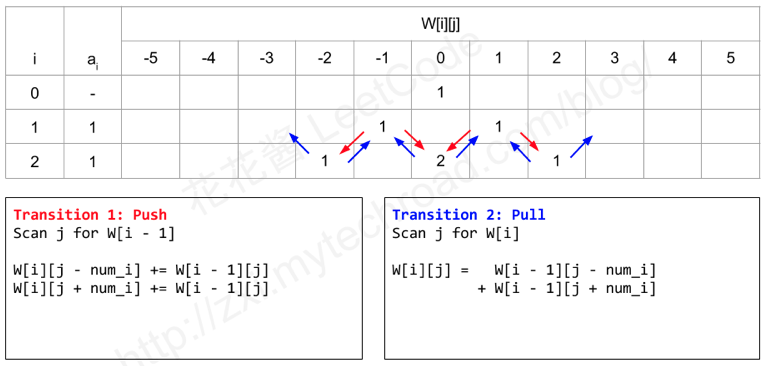本篇总结了栈的使用,关键是能有使用栈的意识,以及确定栈中保存的是什么元素。栈的使用也与许多树操作有关。
相关问题
394 Decode String
将字符串用 k[encoded_string] 的方式编码,将通过这种方式编码的字符串解码。以下有几个例子。
1 | s = "3[a]2[bc]", return "aaabcbc". |
使用两个栈
两个栈分别保存数字和字符串,数字栈保存字符串重复次数,字符串栈保存当前解码后的字符串。将待解码串从左到右地遍历:
- 当遇到数字时,判断是否为多位数,将解析后的整数入数字栈;
- 当遇到左括号时,先将已读取字符串
res入栈,再将其清空,准备开始读取括号内部的新字符串; - 当遇到右括号时,数字栈出栈,栈顶元素为
k;字符串栈出栈,栈顶元素为temp,将res赋值为temp+ k *res。 - 最后
res即为解码后的字符串。
1 | public class Solution { |
一个更直接的递归解法
1 | class Solution { |
使用递归的方法,每一次递归地调用 decodeString(const string&, int&) 都执行一次对形如 k[encoded_string] 的解码。注意该函数签名,两个参数都使用其引用,因此函数内部的 i++ 对后续的 index 遍历都有影响。
以 3[a2[c]]2[d] 为例,decodeString 被依次调用时,返回的字符串分别是(TO CHECK):1
2
3
4
5res = cc
res = acc
res = accaccacc
res = dd
res = accaccaccdd
341 Flatten Nested List Iterator
341. Flatten Nested List Iterator
Given a nested list of integers, implement an iterator to flatten it.
Each element is either an integer, or a list – whose elements may also be integers or other lists.
Example 1:
Input: [[1,1],2,[1,1]]
Output: [1,1,2,1,1]
Explanation: By calling next repeatedly until hasNext returns false,
the order of elements returned by next should be: [1,1,2,1,1].
这道题与 173 题极其类似,都是实现一个迭代器。刚做完 173 题时看到这题很快就想到只要倒序入栈,访问 next 元素时只要出栈并处理就可以了。但一开始犯了一个小错误,就是仍与 173 题一样通过 stack.isEmpty() 来决定 hasNext(),这就使一些很难处理的情况成为漏网之鱼:[[[]],[]],这其实是空的,但栈中不空!
其实只要简单修改一下,让主要的判断操作放在 hasNext() 中,在该函数中就将需要 flatten 的 List 都 flatten,(对于 true 的情况只要)使栈顶保持是一个整数即可。此时也就更方便地排除 [[[]],[]] 这种情况了:这时只要经过判断返回 false,next() 就不会执行。注意最外层的 while 循环。
1 | public class NestedIterator implements Iterator<Integer> { |
385 Mini Parser
Given a nested list of integers represented as a string, implement a parser to deserialize it.
Each element is either an integer, or a list – whose elements may also be integers or other lists.
Note: You may assume that the string is well-formed:
- String is non-empty.
- String does not contain white spaces.
- String contains only digits 0-9, [, - ,, ].
迭代式方法:使用栈
这道题与 394. Decode String 有点类似,都可以使用栈解决。只不过题目中有些地方没有明确,比如 [[]] 这种 corner case,很恶心。
刚拿到题的时候,因为刚做了 Decode String,所以理所当然地想到用 String 栈来存储 token(也可能是受到栈的景点应用——算术表达式处理——的影响),将 [、] 和数字分别存到字符串栈中,再用另一个栈保存 NestedInteger,且没有考虑清除在何时将数字进栈(最初是想在每次遇到 ] 时将栈中 [ 之前的数字逐一进栈,但这样就忽略了已经形成列表的 NestedInteger),总之思路变得异常繁琐。做了一百题下来,我发现思路不清楚让解法变得很啰嗦的时候很有可能就是错了!
正确的迭代式解法只需要一个栈,栈中元素是 NestedInteger。依次访问字符串中的每个字符,当遇到 [ 时创建一个新的 NestedInteger 对象,类型是一个 empty nested list。当遇到 , 或 ] 时表示(可能)结束了一个数字,将数字添加到之前的 NesteInteger 中也在此刻进行。需要额外考虑的是 ] 的情况:将 list 添加到其所属 list 的操作也在此刻一并解决(可以思考一下这种情况)。这样分解下来看,其实每个步骤都很简单。最后再加上特殊情况的考虑。
这才是正确解法该有的样子😂。
1 | /** |
递归方法
递归方法是没想起来,不过看了解答之后觉得整个思路也挺清晰的。
在递归函数的内部,首先是停止条件,有两个:
- 字符串为空的时候(对应的是
[]的情况),直接返回 empty list。 - 字符串是单个数字的时候(只需判断首字符是否为
[),返回解析后的整数类型的 NestedInteger 对象。
其他情况就都需要递归了,递归时,首先要做的是分隔「当前层」(最外层)的每个外层 token(指的是整数或列表类型的 NestedInteger),当访问到一个逗号且此刻并未进入某一组 [] 时,就分割出了一个「外层 token」,对每个 token 递归调用函数本身,将返回的 NestedInteger 加入到返回变量中即可。至于如何确定每个外层 token 的起始位置,则利用与迭代式方法中类似的 start 变量来记录起始位置,该变量只当处理过上一个 token 之后才被刷新。
1 | public class Solution { |
739 Daily Temperatures
对给定的一组表示气温的数组,输出每天的「最近的更暖和的一天」距现在还有几天。For example, given the list of temperatures T = [73, 74, 75, 71, 69, 72, 76, 73], your output should be [1, 1, 4, 2, 1, 1, 0, 0].
使用栈记录
本题要求的输出与数组索引密切相关。对于某个气温 T[i],如果能在访问它时确定最近一个高温天是哪项,可能需要从后往前遍历,维持一个严格递增的索引序列,能从该序列中得到 T[i] 的最近高温天。例如,假设 T[10] = 70, 序列为 [20(60), 30(80), 40(90)],那么只需要将 20 出栈,就能得到最近高温天。注意,由于是从后往前遍历,i = 20 对应的那天已经赋值过,且 60 度在后续的遍历中不再需要(因为必会选择新入栈的 10(70))。
从另一个角度考虑,如果对于某个气温 T[i],能在访问它时,确定与它相关(即将它作为最近高温天的那些天)的所有索引,也能将其赋值,这种情况下,栈中保存的是一组未确定的数组索引。每访问到一个索引位置 T[i],不断出栈并比较栈顶索引所对应的气温是否小于 T[i],如果小于就知道 T[i] 是它的最近高温天。每次出栈就完成一次赋值,每个索引只会进栈出栈一次,因此直到最后所有索引都将被赋值(未赋值的都为0)。
总而言之,还是没能清楚地阐述这里的道理。以后再来填坑吧。
从后往前地确定
1 | public int[] dailyTemperatures(int[] T) { |
从前往后地确定
1 | public int[] dailyTemperatures(int[] temperatures) { |
利用「温度可选范围小」的特点,遍历并不复杂
另一种方法也是从右到左地遍历,用另一个数组 next[] 保存每个温度在访问发生时的下一个索引位置。每遍历到一个新索引i,都检查从 T[i] 到 T[100] 在 next 数组中的索引值,取其最小。这种方法比较易懂,主要是利用了一个小技巧,就是温度可枚举(很少),而常数项对算法复杂度的影响不大。
1 | class Solution { |
173 Binary Search Tree Iterator
173. Binary Search Tree Iterator
Implement an iterator over a binary search tree (BST). Your iterator will be initialized with the root node of a BST.
Calling next() will return the next smallest number in the BST.
Note:
next() and hasNext() should run in average O(1) time and uses O(h) memory, where h is the height of the tree.
You may assume that next() call will always be valid, that is, there will be at least a next smallest number in the BST when next() is called.
##
又是一道不看标签🏷想不到用栈实现的题(当然,即使知道用栈也不知道怎么做)。这则帖子其实提示了一些通过题目中的注意点来得到解题启发的想法。比如,「in average O(1) time」可能想到:next() 调用通常可以直接访问到下一个节点,但偶尔允许通过 path 访问子节点的方式在 O(h) 下解决。(只是思考)
接下来思考如何实现 next() 函数,对于某个节点,如果它存在右分支,那么通过访问它的右分支再循环访问其左分支,最后得到的就是 next 节点。这其实和「通过迭代方式中序遍历树」很相似。然而,当它不存在右分支时,(注意左分支元素都比当前元素小)如何得到父节点(以继续寻找 next 节点)?可以发现 next 节点要么在右分支下,要么在「根节点到该节点」的通路上。而在最初访问该节点的遍历过程中,将访问过的节点依次保存到栈中,便可按逆序出栈。这也是中序遍历过程。
1 | public class BSTIterator { |
331 Verify Preorder Serialization of a Binary Tree
331. Verify Preorder Serialization of a Binary Tree
One way to serialize a binary tree is to use pre-order traversal. When we encounter a non-null node, we record the node’s value. If it is a null node, we record using a sentinel value such as #.
1 | _9_ |
For example, the above binary tree can be serialized to the string “9,3,4,#,#,1,#,#,2,#,6,#,#”, where # represents a null node.
Given a string of comma separated values, verify whether it is a correct preorder traversal serialization of a binary tree. Find an algorithm without reconstructing the tree.
Each comma separated value in the string must be either an integer or a character ‘#’ representing null pointer.
You may assume that the input format is always valid, for example it could never contain two consecutive commas such as “1,,3”.
Example 1:
Input: “9,3,4,#,#,1,#,#,2,#,6,#,#”
Output: true
Example 2:
Input: “1,#”
Output: false
Example 3:
Input: “9,#,#,1”
Output: false
使用栈不断收缩

在 “stack” 标签的提示下容易想到这种解法。其实与树的迭代式遍历相关的问题都会与栈有关。不过一开始做的时候在「遍历时套循环来解决栈不断弹出」部分的时候遇到了问题,当时的思路是一遍一遍地遍历 LinkedList 处理 “X##” 类型的连续串知道串不在减小,好像也可以,但是显得很复杂。要灵活用好循环结构。不过下面这段代码其实有一些地方值得优化,但优化后的代码虽更高效但也更复杂一些。
1 | public boolean isValidSerialization(String preorder) { |
另一种解法:出度和入度
如果将二叉树的边看做是从父节点到子节点的有向边,利用图论中「出度和入度」的定义,可知:
- 非叶节点(非“#”节点)的出度为2,入度为1;
- 叶节点(“#”节点)的出度为0,入度为1。
即每个节点的入读相同,都为1。在通过前序遍历来重绘树结构时,跟踪一个变量 diff = out_degree - in_degree。此外,为了让每个点都有1个入度,给根节点一个“悬浮”的入边(使其与其他节点保持一致)。这样,当树重绘完成后,所有节点的出度与入度之和应相等(加上根节点的“悬浮”入边对应的点),且在遍历访问每个节点时,diff 都不会为负(那样意味着在没有相应入边时就绘制了点)。
YouTube 上的一则视频用例子分步讲解了算法过程。
1 | public boolean isValidSerialization(String preorder) { |
402 Remove K Digits
Given a non-negative integer num represented as a string, remove k digits from the number so that the new number is the smallest possible.
Note:
- The length of num is less than 10002 and will be ≥ k.
- The given num does not contain any leading zero.
Example 1:1
2
3Input: num = "1432219", k = 3
Output: "1219"
Explanation: Remove the three digits 4, 3, and 2 to form the new number 1219 which is the smallest.
这道题还是比较容易想到的。只要「每次删的字符能保证是所有可能情况中最小的」就可以了——其实是一种贪心思想。我在实现的时候是在循环中,找到一个比后一位大的数字就删除,并 break 进入下一次循环。这一过程中出现了一些冗余:看了其他人的解答一下子反应过来可以用栈(考虑到最后需要删除字符串首的0,可以用双端队列)来实现。下面的解法使用了双端队列。
1 | public String removeKdigits(String num, int k) { |